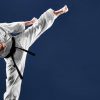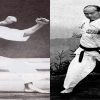He was an innovator, a maverick. The structured forms of the traditional martial arts bored him. Discarding their outmoded model, he became the creator of a new style based not on established techniques but on the realities of combat he knew so well. With it, he won more than 60 battles and became a legend before reaching middle age.
The name of the martial artist I’m referring to, of course, is Miyamoto Musashi, a samurai swordsman who lived during the violent reign of Japan’s Tokugawa shoguns, a man whose real-life exploits make the celluloid antics of the greatest action stars pale in comparison.
Early Days
The son of a minor samurai, Musashi devoted himself early on to the art of kenjutsu and was rarely seen in his village without a wooden practice sword in hand. He killed his first opponent, a renowned master, at age 13 and soon afterward abandoned his family to lead a life of constant wandering, accepting challenges from and issuing them to Japan’s finest kenjutsu practitioners.
When his progress with the single sword was complete and his prowess was evident, he began using the samurai’s shorter second blade, as well and founded the Nito Ryu, or two-sword school. Finally, his supremacy in the art was obvious, even to a perfectionist like Musashi, and he retired to a mountain cave, living as a hermit the final months before he died. There, he wrote his book of strategy, titled Go Rin No Sho.
Some readers will see little relevance in the history of a swordsman whose heyday was three centuries ago, but the passage of years has not changed everything. Today, we still see judoka and karateka who are not so different from Musashi, people who give no thought to bodily comfort, who seemingly live for the next tournament with their every spare moment spent in training.
The question then is really, How is it that Musashi is remembered as the most popular folk hero of his country while modern counterparts are quickly forgotten by fans after, and sometimes before, they retire from the competition?
Perhaps the answer may be found in Go Rin No Sho, the Book of Five Rings, a mysterious text of swordcraft that Musashi wrote to explain his philosophy of combat. In Japan, the book is as admired by businessmen as it is by budoka. Executives use its precepts in corporate dealings and in making their companies more efficient, for Musashi believed that what worked for samurai in battle worked in any relationship, and what applied in single duels was equally true in encounters with thousands. With English-language editions widely available, all Western martial artists would do well to study Go Rin No Sho.
Main Influences
Miyamoto Musashi was a practical man, so it’s natural to expect his words to be simple and easily grasped. Instead, modern readers are confronted with pages of obscure epigrams and enigmatic advice. The reason for this is twofold. Like most samurai, Musashi was a follower of Zen, which stresses intuition over reasoning and holds that it is best to make instructions vague so that students will search deeply for their meaning.
Second, Musashi’s methods were intensely personal, gained from a lifetime of experience, and relating them often proves difficult. It is harder still to read of them with understanding in an era so far removed from ours and in a culture so totally different. But to dismiss Go Rin No Sho because of archaic style is a loss, for its lessons are as applicable now as they were when the roving swordsman extraordinaire wrote them.
The real secret of Musashi’s success, of course, was his tremendous drive for excellence. Almost his entire life was directed to a sole purpose: being the best swordsman possible. To anyone with a goal of similar profundity, he advised, “Make your body like a rock, and 10,000 daggers cannot touch you.”
Developing a mind and body so impervious to harm led Musashi to adopt bizarre habits. He rarely bathed so as not to be caught without a sword, and he often slept outside in rain and snow to harden himself. Most important, he dedicated long hours to incessant, concentrated practice.
His stone-like stoicism may be impossible to emulate nowadays, but students should approach their workouts with the same intensity as Musashi, regardless of the time given them. Such devotion, however, must not prevent an individual from acquiring other abilities. Musashi had little respect for narrow-minded budoka who followed that restricted way, and he extended his own interests to painting and poetry and made a profession occasionally of the engineering trade.
“You shouldn’t have a favorite weapon. Avoid copying the style of others, but strive to handle all weapons equally well.” When Musashi wrote this, maybe he was remembering his only defeat. Although he was matchless with the sword, the age of the bushi (warrior) spawned an endless variety of weaponry, and Musashi could never be sure what his next enemy would wield.
Once, he was challenged by Muso Gonnosuke, a man he’d fought before, an expert with the jo, or short staff. Although Musashi had won in their initial meeting, the second match was long and hard. When Gonnosuke finally trapped Musashi’s blade, he spared his life just as Musashi had allowed Gonnosuke to live earlier.
Modern Applications
Variety is no longer a major factor in martial arts tournaments, but the competitor who familiarizes himself with other styles still has an advantage over those who limit themselves. It is common at karate competitions, for instance, to see contestants grappling ineffectively, too close to applying karate’s moves. This is a fine opportunity to use judo’s sweeps, though, and if a karateka has studied them, he or she will very often best an opponent ignorant of the art.
What would Musashi have thought of the impressive kicks and strikes seen in modern competitions? “To deliberate over many ways of cutting down a man is an error. Killing is the same in the end, for those proficient at it and those who are not. We can speak of a few different ways to do it, but defeating an enemy is the way, and there is no need for much refinement of it.”
Hundreds of kenjutsu styles began in Musashi’s era, with countless techniques. There were sword cuts with exotic names like “Chinese bamboo stroke” and “pear splitter,” cuts intended to sever a thumb or to be used while lying down or in a darkened room. Musashi saw them all and rejected them.
For him, winning usually meant killing, and he couldn’t afford to try a cut just because it looked good.
Legacy
Miyamoto Musashi’s life has been fictionalized several times for Japanese audiences into mini-series and books with the most famous being Eiji Yoshikawa’s epic novel Musashi.
Aside from popular culture, The Book of Five Rings has been studied extensively, not just by martial artists or practitioners of Zen, but also by businessmen looking to employ his strategies.


































